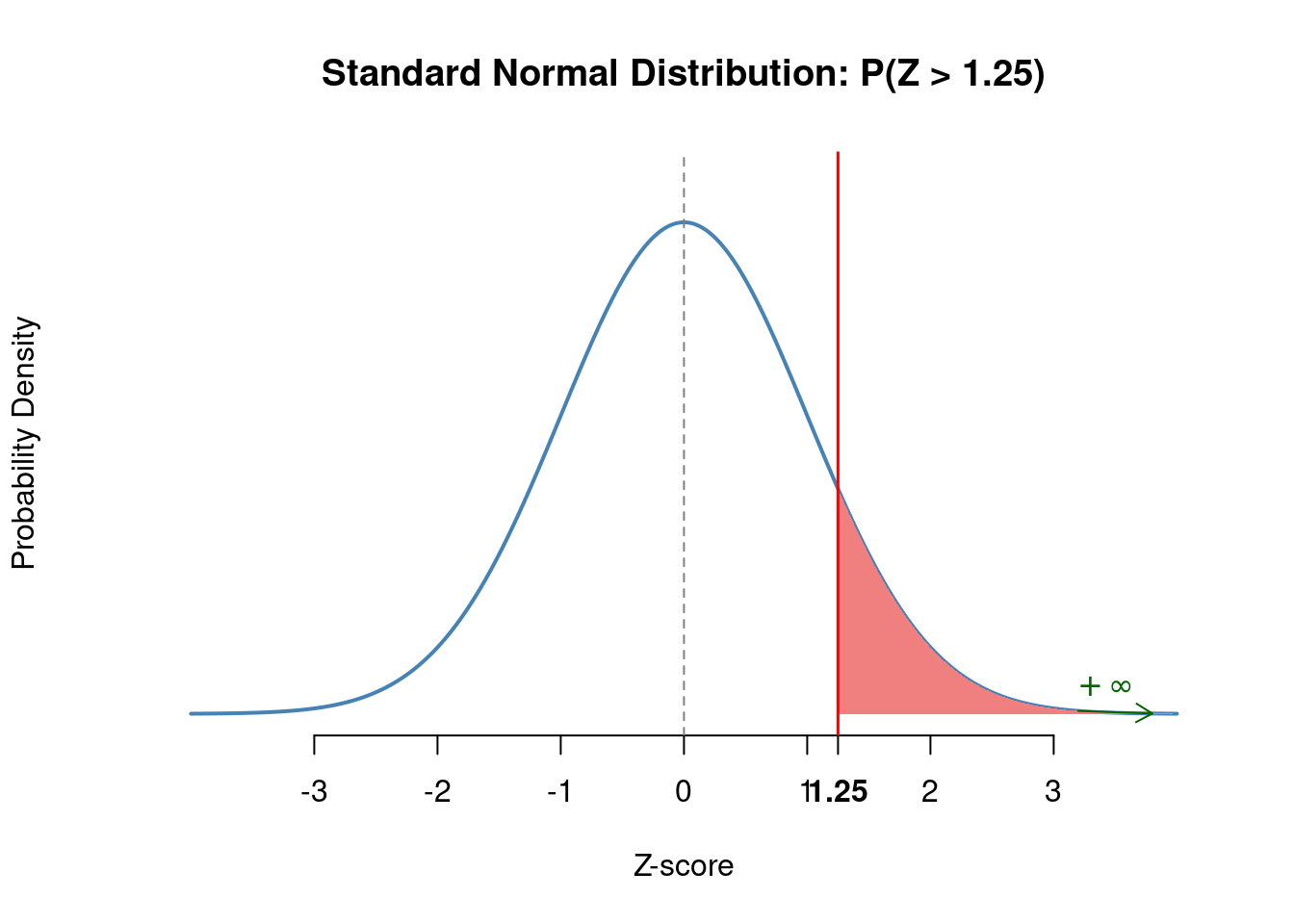
Normal Distribution
Invalid Date
Most Important
It’s the
- most important distribution
- most common distribution
- most widely-used distribution
Shape

The normal PDF is given by
\[ f(x) = \frac{1}{\sigma\sqrt{2\pi}} e^{-\frac{1}{2}\left(\frac{x-\mu}{\sigma}\right)^2}; -\infty <x<\infty \]
- First discovered by Abraham De Moivre
Binomial to Normal
- Number of trial (n) is large (\(n \rightarrow \infty\))
- \(P(S) \approx P(\bar S\)), where \(S =\) Success
Poisson to Normal
\(m \rightarrow \infty\)
\[ \lim_{m \to \infty} \text{Pois}(m) \approx \mathcal{N}(m, m) \] Check out here
Empirical Rule
68‑95‑99.7 Rule

Empirical Rule Area
- \(P(\mu - \sigma \le \mu + \sigma) = 0.6826\)
- \(P(\mu - 2 \sigma \le \mu + 2 \sigma) = 0.9544\)
- \(P(\mu - 3 \sigma \le \mu + 3 \sigma) = 0.9973\)
Properties
- Bell-shaped
- Symmetrical about mean
- \(\beta_1 = 0, \beta_2 = 3\)
- \(\mu = Me = Mo\)
- Area under whole curve is 1
- The curve on either side of mean extends up to infinity.
- All odd central moments are zero
More Properties
- Empirical rule
- Linear combination of Normal \(\rightarrow\) normal
- \(MD(\bar X) \frac 45\sigma\)
- \(QD = \frac 23\sigma\)
- \(M_X(t) = \mathbb{E}[e^{tX}] = \exp\left(\mu t + \frac{1}{2} \sigma^2 t^2\right) -\infty \le t \le \infty\)
Odd Central Moments
\(\mu_1 = \mu_3 = \cdots = \mu_{2n+1} = 0\)
Mathematically Why? > -
Application or Normal Distribution
- Quality Control in industry
- Most distributions tend to be normal under some assumptions
- Sometimes transformation makes normal
- Used in hypothesis testing (many samples are normally distributed)
Standard Normal
If \(X \sim N(\mu, \sigma ^2), z = \frac{x-\mu}{\sigma} \sim N(0,1)\)
- \(\displaystyle f(z) = \frac{1}{\sqrt{2 \pi}}e^{\frac{-z^2}{2}}\)
- \(E(Z) = 0\)
- \(V(Z) = SD(Z) = 1\)
Standard Normal Mean
Let \(X \sim N(\mu, \sigma ^2)\)
- Now let \(\displaystyle Z = \frac{X-\mu}{\sigma}\)
- \(E(Z) = E(\frac{X-Z}{\mu})\)
- = \(\frac{1}{\sigma} E(X-\mu)\)
- = \(\frac{1}{\sigma} [E(X) - E(\mu)]\)
- = \(\frac{1}{\sigma} (\mu - \mu)\)
- 0
Standard Normal Variance
\(V(Z) = V(\frac{X-Z}{\mu})\)
- = \(\frac{}{}\)
Normal Problems
Find Skewness
Find the coefficient of skewness of normal distribution with variance 4.
- \(\mu_3 = 0\)
- \(\sigma^2 =\mu_2 = 4\)
- \(\gamma_1 = \sqrt{\beta_1} = \frac{\mu_3}{\sqrt{\mu_2^3}}\)
- \(\gamma_1 = \frac{0}{\sqrt{4^3}} = 0\)
- So no skew (symmetric)
Probablity of Z [-1, 1]
Find \(P(-1 \le z \le 1)\)
- \(P(-1 \le z \le 1)\)
- \(P(-1 \le z \le 0) + P(0 \le z \le 1)\)
- \(0.3413 + 0.3413\)
- 0.6826
Method 2
- \(P(-1 \le z \le 1) = P(z\le1) - P(z \le -1)\)
- \(P(z \le -1) = 1- P(z \le 1)\) (since symmetric)
- \(P(-1 \le z \le 1) = P(z\le1) - [1- P(z \le 1)]\)
- \(2 P(z \le 1) - 1\)
- \(2 \times 8413-1 = 0.6826\)
Find MD of N(20, 25)
- \(\mu = 20 , \sigma^2 = 25\)
- \(\sigma = 5\)
Mean Deviation about Mean
- \(MD(\bar X) = \frac45 \sigma\)
Find Varinace
Find the variance of normal distribution when \(\mu_4 = 2\)
- Kurtosis, \(\beta_2 = \frac{\mu_4}{\mu_2}\)
- Mesokortic \(\rightarrow \beta_2 = 3\)
- \(3 = \frac{2}{\mu_2^2}\)
- \(\mu_2^2 = 0.67\)
- \(\sigma^2 = ?\)
- \(\sqrt{0.67}\)
P(X > 20)
\(\mu = 15, \sigma = 4, P(X > 20)= ?\)
- \(P(X > 20)\)
- \(P(\frac{x-\mu}{\sigma} > \frac{20-15}{4})\)
- \(P(z>1.25)\)
- \(P(0\le z \le \infty) - P(0\le z \le 1.25)\)
- \(0.5 - 0.3944 = 0.1056\)

Exam Score
Scores on the GMAT are roughly normally distributed with a mean of 527 and a standard deviation of 112. What is the probability of an individual scoring above 500 on the GMAT?[source]
- \(\mu = 527, \sigma = 112\)
- \(P(X > 500)\)
Gestation
The length of human pregnancies from conception to birth approximates a normal distribution with a mean of 266 days and a standard deviation of 16 days.
- What proportion of all pregnancies will last between 240 and 270 days (roughly between 8 and 9 months)?
- What length of time marks the shortest 70% of all pregnancies?
Forest burn
The average number of acres burned by forest and range fires in a large New Mexico county is 4,300 acres per year, with a standard deviation of 750 acres. The distribution of the number of acres burned is normal.
- What is the probability that between 2,500 and 4,200 acres will be burned in any given year?

docs.statmania.info | Abdullah Al Mahmud | Press space or arrow to change slides